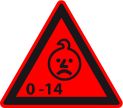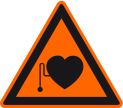Safety first!
The Stickbit contains a Neodymium magnet. Please read the overall safety instructions about Neodymium magnets:
The Stickbit contains a Neodymium magnet. Please read the overall safety instructions about Neodymium magnets:
 Danger
|
Swallowing Children could swallow small magnets. If several magnets are swallowed, they could get stuck in the intestine and cause perilous complications. Magnets are not toys! Make sure that children don't play with magnets. |
|
 Danger
|
Electrical conductivity Magnets are made of metal and conduct electricity. Children might try to put magnets into a power outlet and thereby suffer from an electric shock. Magnets are not toys! Make sure that children don't play with magnets. |
|
 Warning
|
Contusions Big magnets have a very strong attractive force.
|
|
 Warning
|
Pacemaker Magnets could affect the functioning of pacemakers and implanted heart defibrillators.
|
|
 Warning
|
Metal splinters Neodymium magnets are brittle. Colliding magnets could crack. Sharp splinters could be catapulted away for several meters and injure your eyes.
|
|
 Caution
|
Magnetic field Magnets produce a far-reaching, strong magnetic field. They could damage TVs and laptops, computer hard drives, credit and ATM cards, data storage media, mechanical watches, hearing aids and speakers.
|
|
 Caution
|
Combustibility When machining magnets, the drilling dust could easily ignite. Stay away from machining magnets or use appropriate tools and sufficient cooling water. |
|
 Caution
|
Combustibility When machining magnets, the drilling dust could easily ignite. Stay away from machining magnets or use appropriate tools and sufficient cooling water.. |
|
 Notice
|
Influence on people According to the current level of knowledge, magnetic fields of permanent magnets do not have a measurable positive or negative influence on people. It is unlikely that permanent magnets constitute a health risk, but it cannot be ruled out entirely.
|
|
 Notice
|
Splintering of coating Most of our neodymium magnets have a thin nickel-copper-nickel coating to protect them from erosion. This coating could splinter or crack due to collision or large pressure. This makes them vulnerable to environmental influences like moisture and they could oxidise.
|
|
 Notice
|
Oxidation, corrosion, rust Untreated neodymium magnets oxidise quickly and disintegrate. Most of our magnets have a nickel-copper-nickel coating to protect them from corrosion. This coating provides some protection against corrosion, but it is not robust enough for continuous outdoor use.
|
|
 Notice
|
Temperature resistance Depending on the magnet type, neodymium magnets have a maximum working temperature of 80 to 200 °C. Most neodymium magnets lose part of their adhesive force permanently at a temperature of 80°C.
|
|
 Notice
|
Mechanical treatment Neodymium magnets are brittle, heat-sensitive and oxidise easily.
|

